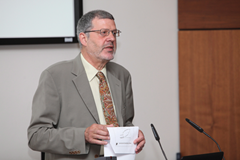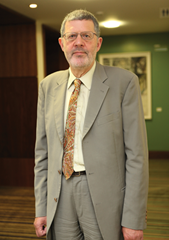Integrated EU electricity: Paul Gorecki
 Professor Paul Gorecki tells Stephen Dineen about the likely impact of an integrated electricity market on the SEM, and what will be needed to realise its full potential.
Professor Paul Gorecki tells Stephen Dineen about the likely impact of an integrated electricity market on the SEM, and what will be needed to realise its full potential.
With the establishment of an integrated EU electricity market, Ireland’s Single Electricity Market (SEM) is likely to experience greater competition in electricity generation and increased fuel diversity according to Professor Paul Gorecki. The academic is a research professor in the Economic Social and Research Institute (ESRI) in Dublin and was Director of the Northern Ireland Economic Council between 1992 and 2000.
After the establishment of the SEM in 2007, the island of Ireland is now scheduled to enter an EU integrated electricity market in 2016. Whilst mainland Europe will integrate in 2014,
facilitated through legally binding network codes, Ireland will have transitional arrangements in place by the same year.
An integrated market, believes Gorecki, will mean a single wholesale electricity price across the EU “apart from obvious [price] differences due to physical constraints.” The litmus test for full integration into an EU market will be the ability of a hypothetical monopolist of the Irish market to raise its price by 5-10 per cent above the competitive level on a sustainable basis. “If it can do so then Ireland has a separate market,” he says. “If it can’t then Ireland is part of a wider market.”
Such integration will follow on from what Gorecki says has been a successful SEM on this island. He says there is “a general agreement that it has worked well in terms of providing an efficient market that provides sufficient capacity, a cost- reflective price and the lowest available price that you can pay given the generation that’s available.”
However, Ireland is “a small isolated market,” he states, “with a relatively small number of players involved, so it’s an oligopolistic market.” Such structures are typically not considered to be competitive and can lead to anti-competitive outcomes such as higher prices, though the SEM tries to neutralise these. With an integrated market the market power of these players will decline, believes Gorecki.
Increased competition will follow, he believes, with at least two consequences. There is likely to be greater security of supply through increased fuel diversity, “through access to nuclear, if the UK goes ahead with its ambitious building of power stations, and also access to nuclear in France and hydro from Norway.” Gorecki says this access will also lead to a reduction in generation reserves needed in the case of an emergency.
Competition will also reduce high salaries. “It’s argued that because of the way in which the markets worked until now some people might have been paid more than they otherwise would be,” he states, “and if you start having competition from other markets this will no longer be sustainable. And as a result you will get an adjustment in terms of wage rates.”
Interconnection
Wind energy, Gorecki believes, will be accommodated more effectively. While the Republic has a target of 37 per cent of electricity from wind energy by 2020, there are physical limitations to the amount of wind that can be accommodated within the SEM, but “one way of utilising that wind is by utilising interconnection so it can be sold into British Electricity Trading and Transmission Arrangements [BETTA] and other markets.”
These benefits from an integrated European market will not be fully realised, says Gorecki, without further increases in interconnection capacity. The SEM is connected to the Great Britain market through the Moyle interconnector. The east-west interconnector is due to be completed in late 2012. “A lot of the work that’s been done suggests that in order to reap the additional benefits of access to the internal market you need perhaps another 1,000 megawatts of [interconnector] capacity,” he states, “and it’s unlikely that they’re going to be onstream in the near future.”
Furthermore, Great Britain will also have to increase interconnection to mainland Europe. Interconnection, which only supplied 2 per cent of its electricity in 2004, is increasing, however. The 2011 UK white paper on the future of electricity suggests it could supply approximately 10 per cent by the 2020s if current proposals are realised.
 Gorecki says that whether interconnection comes onstream in 2014 or 2016 “is neither here nor there,” adding: “You don’t want to suddenly ratchet up the amount of interconnection that’s taking place all over Europe.” In terms of undersea cables “that would put very great pressure on the supply, which leads to much higher prices for the cable and there’s limited availability. It’s much better to do it over a longer period of time and do it at less cost.”
Gorecki says that whether interconnection comes onstream in 2014 or 2016 “is neither here nor there,” adding: “You don’t want to suddenly ratchet up the amount of interconnection that’s taking place all over Europe.” In terms of undersea cables “that would put very great pressure on the supply, which leads to much higher prices for the cable and there’s limited availability. It’s much better to do it over a longer period of time and do it at less cost.”
Another component required to fully realise the benefits of an integrated EU electricity market is a reduction in transactions costs. Due to differences between the rules governing SEM and BETTA, traders require a premium to cover factors such as price uncertainty. However, moving the SEM closer to the BETTA model will require considerable changes to the SEM. “There needs to be a way of accommodating the solution needed to allow a switch in system or a revision in the SEM to facilitate trade, which utilises interconnection between Ireland and the integrated European electricity market.”
Other factors which will affect the SEM’s entry into an integrated EU electricity market need to be examined. Reform of the UK electricity market, including the introduction of a carbon floor price, “may lead to a tax, reflecting the difference between the carbon floor price and the EU’s European Trading Scheme [ETS] price,” states Gorecki. “That price can’t be readily reflected by the current SEM rules.” This raises questions about whether the costs will be absorbed by Northern Ireland generators or if Ireland will have to introduce a similar carbon price.
There is also the question of what options are available apart from SEM or BETTA: “Reference has been made to power exchange models but another example is the Iberian model which has some similarities with SEM and perhaps that’s an alternative that could be considered.”
The future regulatory environment for wind energy also needs to be examined, Gorecki believes. He says we should look at whether tradable permits could be established, similar to those under the EU ETS system. It is worth exploring the possibility of a system in which Ireland “if it produces surplus wind generated electricity, could trade it to another member state which has a deficit, leading to a more efficient allocation and way for wind energy to be generated across the EU.”
Such an option is all the more pertinent given the Republic’s subsidy of wind energy and its renewable energy target. He comments: “To some degree if you’re exporting wind, though you obviously want to export it, it influences the prices at which the SEM is set (and therefore exports). To some extent consumers in other countries are benefiting from subsidies in this country, so you want to find some way in which you can recapture that while at the same time encouraging wind production.”





